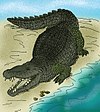Portal:Reptiles/Reptile articles/70
Deinosuchus is an extinct genus related to the alligator that lived 80 to 73 million years ago (Ma), during the late Cretaceous period. The name translates as "terrible crocodile" and is derived from the Greek. Although Deinosuchus was far larger than any modern crocodile or alligator, with the largest adults measuring 10.6 m (35 ft) in total length, its overall appearance was fairly similar to its smaller relatives. It had large, robust teeth built for crushing, and its back was covered with thick hemispherical osteoderms. One study indicated Deinosuchus may have lived for up to 50 years, growing at a rate similar to that of modern crocodilians, but maintaining this growth over a much longer time.
Deinosuchus fossils have been found in 10 US states, including Texas, Montana, and many along the East Coast. Fossils have also been found in northern Mexico. It lived on both sides of the Western Interior Seaway, and was an opportunistic apex predator in the coastal regions of eastern North America. Deinosuchus reached its largest size in its western habitat, but the eastern populations were far more abundant. Deinosuchus was probably capable of killing and eating large dinosaurs. It may have also fed upon sea turtles, fish, and other aquatic and terrestrial prey. (see more...)

